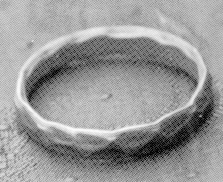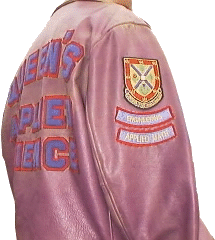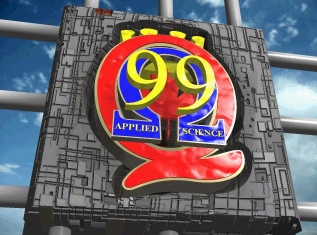Elements of the Engineering Tradition
The IRON RING
The Iron Ring, worn on the little finger of the working hand,
symbolizes our membership in the Engineering family. The heritage of the ring is of unique
importance to Canadians, since Canada is the only nation which upholds the tradition of
honouring and distinguishing our Engineering graduates.
Near the end of their final year, Engineering students attend the private and voluntary
Ritual of the Calling of an Engineer. This ceremony marks the end of the
struggle to become an Engineer. Sometimes known as the Kipling Ritual,
the ceremony was developed and instituted by Kipling at the suggestion of Herbert
Haultain, University of Toronto, and has remained virtually unchanged since its inception
in 1925.
The ring itself symbolizes both the pride we have in our profession
and, at the same time, our humility. The rings were originally crafted
from the twisted iron that remained after the first Quebec bridge ever constructed
collapsed due to a design flaw. A subsequent inquiry revealed the flaw to have
resulted from an error in judgement made by the bridge's engineers.
The bridge was part of the National Trans-Continental Railway linking Winnipeg,
Manitoba, to Moncton, New Brunswick. Construction began on the bridge in 1900. On
August 29, 1907, as the bridge neared completion, it collapsed under the weight of a
locomotive loaded with steel. Seventy-five people lost their lives in the disaster.
A second attempt to span the river resulted in catastrophe on September 11, 1916,
when the centre span of the bridge fell while being hoisted into place. This time, ten
more lives were lost.
The bridge was finally completed in October 17, 1917, and has since been renamed the
Pierre LaPorte Bridge. Although the rings are no longer made from the steel of the
bridge, the significance of the Iron Rings remains unchanged.
Around the beginning of January in their graduating year, the soon-to-be-recipients
emphasize that fact by tapping their pens and pencils on just about anything they
see. (The taptaptaptaptap-ing, of course, is reminiscent of the noise that
the ring makes if you tap it on a hard surface. This may seem obvious -- but, you
never know, there might be Frosh reading this.)
The Legend of the Tam
(from the Science Journal – 1951)
An ancient legend found in the ruins of an old castle near Coventry, England tells the
source of the famous Queen's Science Tam.
It seems that about 1200 AD, the engineers of that day were wearing steel helmet, and
as every engineer knows, the condensation of fog and the subsequent evaporation made the
helmet both damp and uncomfortably cold. Besides, what engineer wanted to be in a fog?
Also, in order to avoid a clanging sound in their ears when hit over the head with a club,
the engineers rose as a body and rejected the ancient Roman headgear. (All except the
King, who was honorary member and wore a crown gear). Still, they needed more head
covering, for there were pigeons in England as well as in Grant Hall. The engineers,
crafty fellows under any circumstances, were impressed by Pierre la Bull-Shooter, inventor
of the time (and the line) and started to wear the touque. But the English pigeons being
nobody's fools, came in at an odd angle. Hence the flatter, more protective tam was
developed, supposedly about 1227.
Scottish engineers soon adopted the tam, and to emphasize that they were much better
than English engineers, added a distinctive braid around it. The Scottish were quite
experienced and there soon came a time when they were needed. For one day the King of
Scotland found himself in the dark, an experience enjoyed as well by some engineers of the
day.
First, however, the court jester was called, and he found the situation uproariously
funny and laughed his fool head off. The King thought this a tremendous idea and the
jester was led away to be beheaded at dawn.
Then the King summoned his chief engineer. The engineer, who was of course a brilliant
fellow, soon threw light upon the mystery. The legend continues that the King's candles
had gone out to get lit and had not returned. The engineer was almost at his wick's end,
when in rolled the candles. The engineer, with a scorching blast, set them aflame and at
last everybody saw the light.
The King, wishing to express his gratitude to the engineer, decreed that thereafter he
and his fellows should wear yellow nuggets of gold on their tams. However, the king, who
had married the Queen for her money, soon found she would permit this (it was her gold)
only if all who wore the nuggets would remain in her service. Hence the engineers were
soon known as Queen’smen, and the name still stands.
Now certain others in the service of her majesty became jealous. They were the writers,
readers, and politicians of the land, who also demanded of the Queen that they be allowed
to were tams with nuggets of gold. These frustrated fellows, however, were denied this
honour and when they approached the Queen, were given the raspberry, which they promptly
put on their hats. The medicine-men, who felt rather blue about the whole affair, started
a campaign, but it all blew over. Finally they adopted one of the bonny blue bells of
their native Scotland to put on top of their tams.
Nowadays of course, the tam has crossed the Atlantic to the new home in Canada, where
it gracefully adorns the head of many a Queen’sman. The gold nugget has disappeared
in favor of a wool tassel. Incidentally, there are several engineers with their
tam-covered heads buried like ostriches at Fort Knox, still refusing to move either their
tams or the hard-earned nuggets.
Science Jackets
These golden, purpled works of art have become the most identifiable
trait of the Queen's Engineer. The gold leather and words Queen's Applied Science are
recognized worldwide, and are all but synonymous with the spirit of the Faculty.
Frosh must wait to join the 95% of Queen's Engineers on campus who own Golden Party
Armour (GPA) and wear it with pride. The new Science Jackets arrive during the Christmas
exam period, but under no circumstances can they be worn until after the last exam has
been written. This ensures an optimum mental state for initiating the new leather.
As well, each new Science year must design a Year Crest to symbolize
their engineering year and adorn their jackets. Soon after frosh week has concluded a
competition is held and each first year student gets the opportunity to vote for their
favourite crest. The artist of the winning crest not only gets their crest put on every
jacket and painted outside Clark Hall, but also receives a free jacket.
Year Crests
Every year during September the first year class must design their official year crest
to represent them throughout their stay at Queen's and for years after. Once they have
chosen their crest, the Frosh can paint it in front of Clark Hall beside
the crests of the upper years. In addition to this, the crest is the most prominent symbol
to appear on the Science Jacket. Finally, upon completion of first year, each year can
proudly display its crest inside Clark Hall Pub alongside other crests dating back to the
1940's.
The year crest is chosen in a design competition amongst the Frosh in September, not
long after classes begin. Members of the year submit their designs which are then put on
display and voted upon by their peers. The person whose design is chosen to be the year
crest not only gets to take pride in their design, but they also get their Science Jacket
for free. There are, however, a few restrictions placed upon the design. It must be done
in the three Queen's colors (red, gold, and blue) and it must have on it a crown, a maple
leaf, the letter "Q", the words Applied Science, and the year (number).
The Engineering Hymn
The tune for 'The Engineering Hymn' is the same as that of 'The Battle
Hymn of the Republic'. This also happens to be the tune that the 'Oil Thigh' is sung
to.
The original song was 'The Engineering Hymn', 'The Oil Thigh' borrowed the melody,
which was subsequently borrowed for 'Battle Hymn of the Republic.' Clearly.
Once arriving here and participating in a few days of frosh week, the frosh groups put
their poetic skills to the test to write their own verse. The best one is selected
and the year verse is proclaimed.
The Well Known Chorus:
We are, we are, we are, we are, we are the Engineers,
We can, we can, we can, we can demolish forty beers.
Drink rum, drink rum, drink rum, drink rum, drink rum along with us,
For we don't give a damn for any old man who don't give a damn for us.
A Few Queen's Verses:
Now you should know by now we can demolish forty beers,
Unlike the stupid ArtScis we will wind up with careers.
An Engineer that's fresh from Queen's earns roughly 40 G's,
While an ArtSci with a Ph.D. can't get work at McD's.
Elvis was a legend; he's the King of Rock and Roll,
But the life that he was leading - well it finally took its toll.
He realized too late that he chose the wrong career,
So he faked his death and came to Queen's - he's now an Engineer.
Some Other Verses:
Venus is a statue made entirely of stone,
There is not a fig leaf on her, she's as naked as a bone.
At noticing her arms were broke an Engineer discoursed,
"The damned thing's broken concert and should be reinforced!"
A drunken Engineer once staggered in through Roddick gate,
He/She was carrying a load that you'd expect to ship by freight.
The only things that held him/her up and kept him/her on his/her course,
Was the boundary condition and the hydrostatic force.
A Commie and an Engineer were stranded on a boat,
But one man was too heavy so the poor boat wouldn't float.
The Engineer would flip a coin to settle the dispute,
So he/she flipped it in water and the Commie gave pursuit.
Now you've heard our story and you know we're Engineers,
We love to love our women/fellas and we love to drink our beers.
We drink to every fellow who comes from far and near,
Cause we're a HELL-OF-A, HELL-OF-A, HELL-OF-A, HELL-OF-A, HELL-OF-AN-ENGINEER!
Gentian Violet
April, 1912. The Unsinkable is sinking.
While all the passengers of the Titanic were under panic and trying to save their own
lives, the engineering crew were working non-stop to keep the furnace running at maximum.
The smoke coming out of the enormous furnace could be seen miles away and gave the exact
position of the sinking vessel to any ship on their way to rescue. The entire engineering
crew of the Titanic went down with the ship.
The colour of the engineers’ overalls on the Titanic was purple. In honour of the
engineers who died on board, purple was made the official colour of the engineering
profession. Like the iron ring in Canada, purple is a reminder to all engineers of the
history and responsibility of their profession.
In the early ‘70's, engineering upper years would dye Frosh's hands purple. By the
later ‘70's, Frosh could expect to have their face or arms purpled (note the use as a
verb) as well. In the early ‘80's, the second year students would literally throw
Frosh in a bathtub filled with the purple agent. Somewhere around 1990, the FRECs realised
that purpling added greatly to their feral image and decided that purple was therefore too
cool to be used for Frosh. Now, only the upper years are allowed to be purple during
Orientation Week. For those who wonder what is the magic ingredient to the purple
solution, here at Queen's, we use gentian violet. A medical dye, it stays
on for a long time and makes you look 8 feet tall!
The Engineering Society Coat of Arms
This is the Engineering Society Crest. Touch it, love it.
It is the power of good incarnate. Well, maybe not, but it carries with it alot of
tradition and heritage.
That's the cross of St. Andrew in the middle -- its deep roots in Scotland
are rivaled only by oatmeal and haggis. From the bottom emblem clockwise we have the
Scottish Thistle, Irish Trefoil, Canadian Pine Tree, and an English Rose. The Eight
Crowns represent royal ties while the 'S' in the background stands for Science. The
hammers represent the foundation of Queen's Applied Science, which originally was the
School of Mining. The book in the centre represents knowledge. The Faculty
itself has been around for 105 years and the Engineering Society is celebrating its
Centennial this year, in 1998.
If you want your own EngSoc Crest, there is no need to butcher your
computer screen with scissors. There's alot of great stuff you can buy here that has
the crest on it. Stickers 'n' bags 'n' stuff. Even a beautiful purple fleece!
Year Prank
Every spring, a rather bizarre series of events occur all over campus. "How
bizarre?" you ask. Well, how do stray cruise missiles, auto wrecks, 260
greasepoles, cemented-over pubs, purple trees, petting zoos and a disco in Stirling Hall
sound? And that's just the beginning! Of course, it's a mere
coincidence that these events tend to occur on April 1st. It's also equally
coincidental that on the night of March 31st the campus is swarming with fourth year
engineers.
Now most people will tell you that it's the fourth year engineers that do these
dastardly deeds, but it just isn't so. Engineers are nocturnal by
nature (due to late night cramming) and come springtime, the fourth years are busily
completing their theses. So on the night of March 31st all they're really doing is
going to the computer clusters or EngSoc to work.
What? You don't believe it?
Just wait until fourth year. We're sure that on the eve of April Fools
Day, you'll be on campus too... working on your thesis.
|